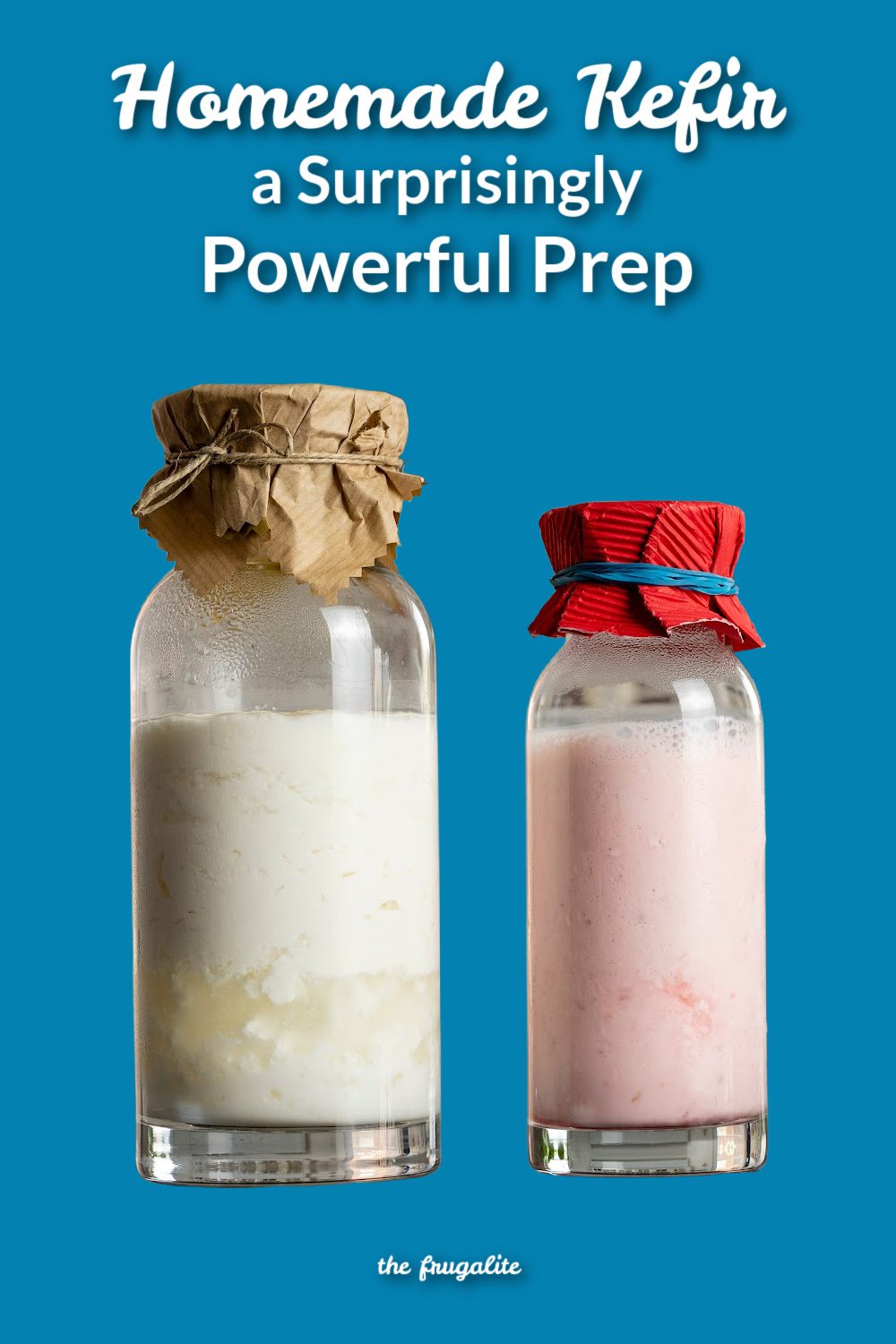(Psst: The FTC wants me to remind you that this website contains affiliate links. That means if you make a purchase from a link you click on, I might receive a small commission. This does not increase the price you’ll pay for that item nor does it decrease the awesomeness of the item. ~ Daisy)
I know this is a bold claim! I have been eating kefir for about ten years, and yes, I do consider it to be one of my ultimate self-sufficient food items. Why would I think that? In this article, I will introduce you to kefir, a cultured milk probiotic food, and its many health benefits.
I will go into some detail about the differences between yogurt and kefir. Bear with me, as this discussion gets a bit technical, but I think overall it will help you appreciate the important differences between kefir and yogurt. This is particularly relevant if you are seeking a probiotic that will support your gut health.
I will also share information about the flexibility of kefir in self-sufficient food production. All of these qualities make it a powerful addition to your supply in these times of supply chain disruptions and inflationary food prices. Of course, I will let you decide whether it will be one of your ultimate additions or not!
What is a probiotic?
In order to describe the differences between yogurt and kefir clearly, I had better start by defining what a probiotic is! According to the Cleveland Clinic, in order for a microbe to be a probiotic, it must have the following characteristics:
- you can isolate it from a human being (i.e., is not a human cell)
- it can survive in your intestine after being eaten
- have a proven benefit to you
- is safe to be consumed
I like this definition, as it emphasizes a probiotic as part of the living microbiome in your gut. A true probiotic does not simply “pass through” you, but actually stops and stays. These are bacteria that support all kinds of healthy human body functions, as you will see below. This “stop and stay” function is also an important way to distinguish between yogurt and milk kefir.
But perhaps we should take a closer look at these differences next…
What is the difference between yogurt and kefir?
Kefir is a live-cultured milk food. You can think of it as yogurt multiplied by…well, maybe a hundred! Let’s look at why this is the case.
We’ll start with yogurt.
Since ancient times, yogurt has been created by two primary “good” bacteria strains: Lactobacillus bulgaricus and Streptococcus thermophilus. While these bacteria create the yogurt, they are not the type of bacteria that we now understand populates your gut and supports immune health. What they do instead is promote some basic gut cleansing and feed the bacteria that actually lives in your gut.
In order to give yogurt true probiotic properties, some companies are now adding probiotic strains of bacteria to regular yogurt. These strains include Bifidobacterium bifidum and Lactobacillus acidophilus. You may have heard of these varieties.
So, to summarize, yogurt does have some gut health benefits. However, unless it is supplemented with true probiotic bacteria, yogurt’s two main bacteria don’t actually stay in your gut.
You can check your own yogurt label to see what bacterial strains it contains. This will help you assess whether it is really a probiotic or not.
Kefir is much more diverse than yogurt, and naturally contains probiotic bacteria.
Some sources report that kefir naturally contains around two dozen or more bacterial varieties and at least nine varieties of yeast as well. Other sources count over 60 different varieties of bacteria and over 48 varieties of yeast and fungus.
How can this be?
Kefir is actually produced by a little live organism that is made up of diverse bacteria and yeast itself. The organisms look like little gelatinous lumps with a kind of cauliflower-like texture. These little lumps are called kefira, or “kefir grains” although they have nothing to do with grains like wheat. The reason they are called “grains” is because many of these little globs make up a colony, kind of like grains of sand.
The kefira are a living combination of diverse bacteria and yeast that exist symbiotically together. Somehow these organisms randomly come together, starting to live on a kind of gelatinous body frame composed of other food building blocks. Their gelatinous frame is made up of carbohydrates (one unique to them called ‘kefiran’) and their interior is made up of a protein called casein – which is also found in milk.
To make kefir, you simply take a small number of these kefira (around two teaspoons) and place them in a quart jar of fresh whole milk. Within 24 – 48 hours, the kefira will begin to digest the lactose in the milk and culture it, leaving a rich tangy liquid that is absolutely chock full of beneficial gut bacteria. In addition, the very part of the kefira that holds them together, this unique kefiran, is also found to be present in the kefir.
Let’s now look at how these little science projects can benefit your body…
What are the health benefits of kefir?
Our understanding of the human body has shifted dramatically in recent years. Now, we have realized that our bodies are actually an interface between our own cells and the beneficial bacteria and yeasts which live both in and on us. In fact, inside of our gut, we now know that there are trillions of gut bacteria and yeasts. They are not optional or accidental: they are required.
No bacteria? No yeast? No health. It’s as simple as that.
Immune Health
Taking probiotics such as kefir can help you maintain this healthy balance of flora in your gut, and there are exciting benefits to your immune system for this:
“Probiotic bacteria can inhibit the reproduction and survival of harmful pathogens in the gut, and they can also regulate the number of antibodies present in the intestines. This, in turn, leads to a stronger immune system that is better suited and prepared to fight off disease and illness.” [source]
Digestive Health
In addition to general immune system benefits, probiotics also provide benefits to the digestive system. Those suffering from irritable bowel syndrome, diarrhea, constipation, and general inflammation in the bowels can all potentially benefit from kefir.
Skin Health
By preventing chronic inflammation, probiotics can actually also help improve our skin health, too.
It turns out that our skin has a microbiome that we now realize is linked to our gut biome. The two communicate in fascinating ways, including through stress hormones and the chemicals produced by the microbes themselves.
And myriad other benefits…
There are other benefits to probiotics, as well: heart health and mental health both improve with the consumption of probiotics like kefir. Some people lose weight when they balance their gut flora. Some women who experience chronic yeast infections also see an improvement when they take probiotics.
Scientific studies are showing significant benefits including anti-tumor, anti-fungal, and anti-bacterial (bad bacteria!) properties. It also seems to support the functioning of our immune systems and even protect the lining of the gastrointestinal tract. That is not all! The kefiran also has anti-inflammatory properties and even acts as an anti-oxidant.
Whew! Those are a lot of benefits from such a little thing.
How to use kefir as a food production prep
As you have seen above, if all kefir had to offer was its health benefits, it would be amazing. However, that’s not all it has to offer, and it’s because of this that kefir is one of the mainstays of my self-sufficient food production.
Kefir is a liquid that you can substitute directly for buttermilk, another cultured milk product. Do you like buttermilk pancakes? Buttermilk biscuits?
If you make your own kefir, you will no longer have to buy buttermilk!
Do you like cheese? I am a cheese lover.
This year’s Canadian Food Price Report is out, and the prices of dairy products are predicted to go up between 6 and 8 percent. When you make kefir at home, you can also use it to make a delicious soft cheese. I find it is a lot like spreadable cream cheese – perhaps a bit tangier. I like to add dried cranberries to mine. You can also make a hard cheese out of your kefir. This cheese is a lot like a goat’s cheese, with a stronger flavor. It is good on pizza, for example.
Want to make your own bread with your stash of wheat berries?
If you make your own kefir, you won’t have to worry if you run out of yeast. Kefir contains yeast, and it can be used as a sourdough starter as a result. In addition, if SHTF and you aren’t able to use pasteurized milk, you can transition your kefira to raw milk.
If you’re interested in finding out more about what’s involved in getting started with making your own milk kefir at home, you are welcome to check out my How To Guide on my website.
Interested in adding kefir to your pantry?
Are you more interested in the health benefits of kefir or its flexibility in self-sufficient food preparation? Could you see yourself getting kefira to make your own kefir? Share your thoughts in the comments below.
About Colette
Colette is passionate about sharing her knowledge of thrifty living and self-sufficiency. She has developed her skills in self-reliance living in the suburbs, the city, and more recently, on her own Half-Acre Homestead. Colette lived five years completely off-grid and without running water in an eight by 24 foot tiny home while designing and building her own 18 by 24-foot eco-cabin. She has just launched her website, Half Acre Homestead. Colette invites you to stop by and visit this work in progress! Coming soon in 2022 is her exciting new online program. Interested in Resiliency, Preventative Health, and Self-Sufficient/Off-Grid Housing (to name a few!)? Stay tuned for more details!












6 thoughts on “Homemade Kefir: The Ultimate Self-Sufficient Probiotic”
I tried Kefir once, it requires a lot of babysitting imo. I just didn’t have time for it unfortunately.
Hi Larry, Quite honestly, I’m so surprised that you had that experience with it. Mine is sitting on the floor right now, having not received any attention for three days now. Later this evening, it will take less than 10 minutes to separate the grains and put the fresh kefir in the fridge. In my opinion, what I get from the grains is priceless (quality of probiotic, quality and quantity) compared to a few minutes every few days. Just the morning, I enjoyed my homemade hand ground spelt Irish soda bread, made with my own fresh kefir.
Could you make kefir w/oatmilk?
Hi Denise, While I don’t think it’s possible to make kefir with oatmilk, you can make kefir with water! For this purpose, it is better to start with water-based kefir grains, although some people have some success converting them, it is a bit of a finicky process. So kefir is absolutely possible for people who want to make it non-dairy. For more info, I highly recommend the “Cultures for Health” website, which has a wealth of information on kefir, as well as excellent starter kits. Also, if you are thinking about getting going, I have a great little “How to Guide” on my website. Here’s a link to that: https://www.halfacrehomestead.ca/how-to-guides It’s the first guide in the list. Wishing you the best!
Kefir once you understand natures process is super easy. Have been making about 2 quarts every week for 5-6 years and before that buying raw kefir from Organic Pastures which only has 12 probiotics on the label and no yeast from mostly A2 milk. Collette my question: do you have any idea how many kinds of probiotics are in homemade raw milk kefir? Mark McAfee of Organic Pastures has stated as many as 800 plus 30% yeast. Because the grains are a live organism the number likely changes over time?
Hi Jim, Thank you for writing. It is such a pleasure to connect with someone who is also a fan of kefir. I especially appreciate your comment about making it being “super easy.” I think it’s one thing if the writer is saying that, but when there is support from the Frugalite community, I think that does help.
Regarding your questions, I can say that it does appear that the live probiotics in finished kefir would not only vary over time, but would vary even from batch to batch. I learned this from the Cultures for Health website. In terms of actually counting the probiotics in raw milk kefir, I wasn’t able to find any direct studies of that. Perhaps you could ask Mr. McAfee if they have done any independent studies at the DNA level of the diversity of their kefir?
I did have a look around on Pub Med to see if I could find any relevant articles to share with you. Here is a study of the diversity of fungal colonies in raw milk in the Italian Alps comparing three different pasture altitudes. Using DNA extraction, they were able to identify a total of 30 fungal species in the milk, with the most diverse sample having 17 species. https://www.ncbi.nlm.nih.gov/pmc/articles/PMC3765600/ So, it’s possible that you could combine the diversity of the raw milk with the diversity of the kefir to get a ball park on how many fungal colonies might be present in the homemade kefir. I think the sources I cited in my article had identified between nine and 48 varieties of fungal colonies in kefir.
One other article, which I was only able to access the abstract, was cited by Cultures for Health. It studied the organisms present in Tibetan kefir grains comparing four samples from different places. In one sample, bacteria were the dominant organism, and in another sample, yeast were the dominant organism. I found this fascinating that the kefir grains themselves can vary so much! Here is a link to that abstract on Pub Med: https://pubmed.ncbi.nlm.nih.gov/22860591/
So, although I can’t exactly answer your questions, I hope I have provided some interesting ideas to add to the mix, so to speak. Wishing you the best!